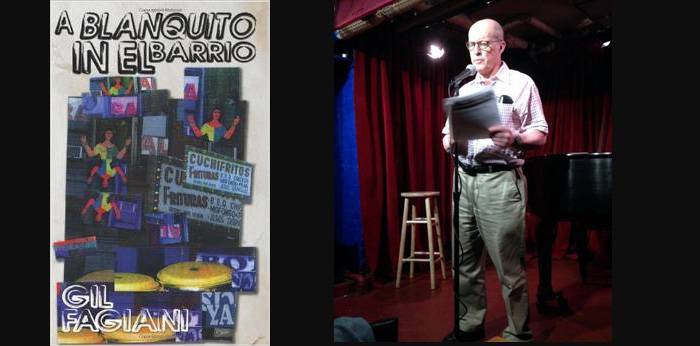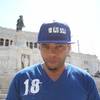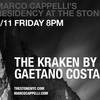Politics and Poetry
Politics and poetry were on the bill at the Italian American Writers Association (IAWA) May 9 reading at the Cornelia Street Café in Greenwich Village. The evening's featured writers, Gil Fagiani and Stephen Siciliano, read work that paid homage to the radical legislator Vito Marcantonio, who for 14 years represented East Harlem in the US House of Representatives. Fagiani read poems from his collection, "A Blanquito in El Barrio" while Siciliano performed, to piano accompaniment, sections from "The Goodfather," his novel-in-progress about Marcantonio's life and times.
Fagiani's poems mostly were about the Puerto Rican community of East Harlem, drawn from his experiences living and working there in the 1960s, by which time formerly Italian Harlem had become, with successive waves of migration from Puerto Rico beginning after World War I, El Barrio, or Spanish Harlem. Siciliano offered several imagined vignettes about Marcantonio's life, from the viewpoint of a fictional Italian family living in Marcantonio's neighborhood.
Arriving in East Harlem in 1966 at age 21 as a Cornell University student, Fagiani worked for three months at a neighborhood anti-poverty agency. "I always think of that experience as my road to Damascus because it totally transformed my life in terms of my cultural tastes, my politics, my friends," he said. "I ended up marrying somebody from the neighborhood."
"East Harlem," he noted, "is a fascinating community with a long tradition of political militancy going back to the early twentieth century." That history includes Italian anarchists, Jewish socialists, Marcantonio's multiethnic urban coalitions of the '30s and '40s, and the revolutionary Puerto Rican nationalism of the Young Lords Party in the late 1960s.
Fagiani said that when he had been in East Harlem only a few days, he witnessed a protest led by a seventy-three-year-old Puerto Rican woman who was an organizer at the anti-poverty agency. In a poem inspired by the protest, the woman, "La Capitana," leads her "troops" of young East Harlemites to the executive offices of the City agency that had cut off funds for the agency's youth program. There, La Capitana banged on the executive's desks "like she's playing the bongos" as "white, suited men pull on their ties."
"It was one of the most brilliant, tactical and creative confrontations I have ever participated in," Fagiani fondly recalled.
Another poem vividly recollected a date with an East Harlem woman who had a lusty appetite for cocina criolla. The poem makes earthy music from the names of her favorite dishes – cuchifritos, morsillas, alcapurrias, pastelitos, rellenas de papa – and "blood sausages thick and black as a policeman's club."
Fagiani read two poems inspired by Vito Marcantonio, both likening him to a saint. Fagiani wrote the first in the voice of a middle-aged Puerto Rican woman who confides that she lit a candle not for Saint Lazarus but for "my congressman Vito Marcantonio, my santito." The poem incorporates an anecdote Fagiani said a Puerto Rican woman had told him: Vito Marcantonio "saved" her son Carlito from neighborhood Italians who had threatened to kill him for supposedly raping the sister of one of them; in reality, the sister had pursued Carlito. The Congressman "smuggled" Carlito on a plane to Puerto Rico, where he hid while Marcantonio "straightened things out in New York."
"Litany of San Vito," Fagiani said, was born from his disgust over the fact that when Vito Marcantonio died (in 1954), New York's right-wing Cardinal Spellman denied him a burial in a Catholic cemetery, stating that the leftist legislator wasn't a Catholic in good standing with the Church. (Spellman, however, didn't object to mobsters being buried in Catholic cemeteries.) "So, in revenge, I wrote this poem," Fagiani said. The poem adopts the form and style of a Catholic Mass card, with lines that cast Marcantonio as a secular saint, a saint of the Left: "San Vito crucified by Wall Street/pray for us/San Vito martyr of McCarthyism/pray for us." The "litany" implores San Vito to protect his devotees from the quotidian East Harlem crises of "immigration raids" and "the landlord's greed"; "the loan shark's vig" and "the social worker's visit."
The secular-minded and non-religious might feel some discomfort at having a hero of the Left – who was not a churchgoer – beatified, even if only in a poem. But, if one thinks of saints as exemplary individuals who exercise power benevolently, and who intercede on behalf of others, then the analogy isn't so unlikely.
Stephen Siciliano called Marcantonio "a once-powerful and influential man who was a victim of McCarthyism." He noted that today "the vast majority of people in New York City and beyond don't know about him."
Siciliano said that in writing "The Goodfather," his task was "to recuperate, revive or recall life in Italian and Puerto Rican East Harlem in the 1920s through the 1950s." In the novel, Siciliano explores "the impact Vito Marcantonio had on regular people" through the experiences of the fictional Fortunato family, working class Italians who are ardent Marcantonio supporters.
As pianist Peter Dizozza played Louis Armstrong's composition "Muggles," Siciliano read "The Sweater," a section of the novel that takes place at a 1920s house party in Harlem. Siciliano noted that Marcantonio "way ahead of his time" regarding the civil rights of African Americans: "He was a fast-talking guy in a fedora who drove the southerners who ran the House of Representatives in those days crazy with his anti-lynching, anti-discrimination proposals, which he promoted with his singular mastery of parliamentary procedure."
In another "Goodfather" section, titled "Tina Modotti," Siciliano imagines an encounter at a 1924 party in Harlem between a young Vito Marcantonio and the title character, an Italian-born photographer who was a Marxist revolutionary and militant antifascist. The party, sponsored by the NAACP, actually occurred; among the guests were the African American leaders W.E.B. DuBois and A. Philip Randolph. "We have no proof these two [Marcantonio and Modotti] ever met," Siciliano said. "It's not unlikely or impossible they might have, given the construction of the international Left in those days." In "The Goodfather," Siciliano uses her "as literary device, as the international siren of revolution."
Siciliano began work on "The Goodfather" seven years ago. While researching the book, he met with historian Gerald Meyer, whose "Vito Marcantonio: Radical Politician, 1902-1954" remains the definitive biography. Over a lunch, Meyer "told me a lot of important things in a very short time." Although "The Goodfather" is a work in progress, the excerpts that Siciliano read at the Cornelia Street Cafe established that he has found an original and poetic way to tell those important things, to a contemporary audience that needs to hear them.
Gil Fagiani and Gerald Meyer are co-founders of the Vito Marcantonio Forum, an organization dedicated to educating about Marcantonio and to preserving the history of East Harlem political radicalism. Visit the Forum's website to find out about future events and activities.





































i-Italy
Facebook
Google+
This work may not be reproduced, in whole or in part, without prior written permission.
Questo lavoro non può essere riprodotto, in tutto o in parte, senza permesso scritto.